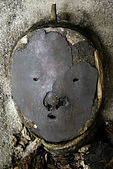
Image credit: Carlos G. Museo Momias Chinchorro / Trip Advisor.

Image credit: Reinhard Schneider / Science Magazine.

Image credit: Nicholson Museum
Image credit: Arriaza 1995a.
The black mummy period lasted 2,180 years from 4980-2800 BCE (Arriaza 1995a).
The production of a black mummy involves the removal of the organs, skin and extremities. The midsection was then dried with hot ashes or coals. Bones were cleaned, dried and then reassembled with supportive sticks. Those in adolescents and younger had more supportive sticks added. The main sticks were body length and ran from the ankles into the skull, but smaller ones also supported the hands and feet. Sticks were then secured with mat fragments and reed cords (Arriaza 1995b).
The bodies were filled to restore their original shapes. The skull and chest would be filled with grass, ashes, soil, or animal hair (Arriaza 1995b).
Finally, the body was painted with white ash paste which was also used to model bodily features. The skin was then placed over the past. However, some may have no skin or skin in patches. Black mummy children in particular were likely to be missing skin. Hair was also reattached (Arriaza 1995b). The final coat of black manganese paint, likely made from Arica’s black sands, gives the mummy its characteristic color and is also used to model bodily features. Skin does not need to be sewn on as with the red mummies as the black paint acts as an adhesive (Arriaza 1995a).

